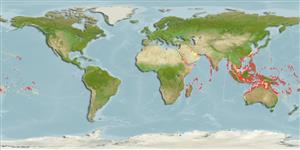Common names from other countries
Environment: milieu / climate zone / depth range / distribution range
экология
; пределы глубины 0 - 42 m (Ref. 117184). Tropical; 31°N - 32°S, 30°E - 124°W
Indo-Pacific: from East Africa to the Red Sea, (but not the Persian Gulf) to as far east as Pitcairn Islands, north to southern Japan, and south to Queensland, Australia and New Caledonia. Introduced in Hawaii and Guam.
Length at first maturity / Size / Вес / Возраст
Maturity: Lm ?, range 16 - 20 cm Max length : 45.0 cm SHL самец/пол неопределен; (Ref. 95990); common length : 30.0 cm SHL самец/пол неопределен; (Ref. 348)
The species has an elongate shell with conspicuous fluted scales on its radial ridges. The valves are white and occasionally tinged with orange, and the mantle yellowish green.
Maximum depth from Ref. 87928. In eastern Polynesia, it is known to be restricted to deep water (Ref. 87928). Found in intertidal areas on corals (Ref. 75831). Abundant on outer reef slope (Ref. 2923). Also found in a lagoon (Ref. 87813), on sandy bottoms (Ref. 106695), rubble or in reef pockets (Ref. 2923). Unattached or weakly attached by byssus as an adult (Ref. 2923). Tridacnids derive their nutrition from uptake of dissolved matter through their epidermis and from their symbiotic zooanthella Symbiodinium microadriaticum (Ref. 107098).
Life cycle and mating behavior
половая зрелость | размножение | нерест | икра | Fecundity | личинки
Life cycle: Embryos develop into free-swimming trocophore larvae, succeeded by the bivalve veliger, resembling a miniature clam (Ref. 833).
Основная ссылка
ссылки | координатор | соавторы
SAUP Database. 2006. (Ref. 356)
Статус Красного Списка МСОП (Ref. 130435)
Статус СИТЕС (Ref. 108899)
Not Evaluated
Использование человеком
рыболовство: коммерческий
FAO - аквакультура (рыбоводство): production; | FishSource | Sea Around Us
инструменты
дополнительная информация
ресурсы в Интернет
Estimates based on models
Preferred temperature
(Ref.
115969): 25 - 29.3, mean 28.4 (based on 3457 cells).
устойчивость к внешним воздействиям
средний (среднего размера), минимальное время удвоения популяции 1.4-4.4 года (K=0.08-0.23; tm=4).
Уязвимость
Moderate vulnerability (39 of 100).
Категория цены
Unknown.
